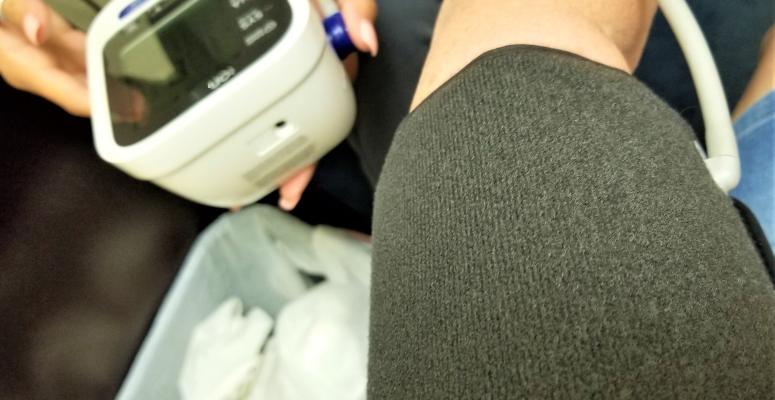
Blood flow restriction (BFR) therapy, also known as vascular occlusion training, helps physical therapy patients increase their muscle strength with minimal stress. While research shows that BFR may be able to help alleviate pain in patients with chronic pain, it primarily is helpful in building muscle. It is frequently used to supplement athletic training but can also be used to grow muscle in patients who are suffering from conditions that could improve with muscle training.
How does it work?
During blood flow restriction therapy, a care provider will use one or several tools that are designed to slow blood flow to either the arms or legs during exercise. Typically, a band will be tightened around the limbs, similar to a blood pressure cuff. The purpose of this band is to reduce blood flow to the muscles in these limbs while also allowing for normal flow to the limbs, in short, alternating intervals during endurance or resistance training. It can be especially helpful for older adults who visit physical therapy clinics and may have limited options for building muscle mass.
Blood flow restriction therapy is designed to provide an accelerated recovery process to patients of all ages and of all conditions. It is specifically known to be able to increase muscle mass, hypertrophy and angiogenesis. BFR is a common type of strength-building and rehabilitative therapy that is used in physical therapy locations across the country.
How safe is blood flow restriction therapy?
Blood flow restriction therapy is a safe and effective technique for those looking to improve muscle performance. Though there is still research to be done on this technique as it can be used in a clinical setting, existing research suggests that it’s a safe and effective technique. About 98% of physical therapists who use this technique in their clinical treatments reported that it was beneficial for their patients. It’s mostly effective in targeting the muscular system, but little is known about whether it can be used to benefit the skeletal and cardiovascular systems. It is generally a good method to employ during physical therapy sessions for boosting muscle strength with the least amount of stress possible, but further research is needed to extensively determine its impact in the clinical setting.
What are some of the tools involved?
- Occlusion cuffs — This is one of the more popular devices to use during BFR therapy. It consists of a band to restrict blood flow and a pressure gauge to manage the pressure applied by the cuff during exercise. The pressure gauges also help therapists track the amount of pressure used on the patient during each session, making it easier for physical therapists to replicate during each session.
- Smart cuff bands — Smart cuffs are a more technologically advanced option for conducting blood flow restriction therapy. This involves the use of a cuff that can track data during exercises. This technology can be helpful for athletes performing exercises outside of physical therapy sessions; however, it’s recommended that athletes use BFR therapy under the supervision of a professional.
What are some of the conditions that it can be used to treat?
Blood flow restriction therapy can be used to treat a variety of conditions. Physical therapists most often use it for people who have the following conditions.
- Sports injury.
- Joint pain.
- Joint replacements.
- Muscle atrophy.
- Osteoporosis.
Not only can blood flow restriction therapy be used to treat the conditions listed above, but it can also be especially helpful for patients who have recently undergone surgery for conditions related to their shoulder, knee, ankle or foot. It can significantly improve recovery time and allow for recuperative exercises to be performed for maximum muscle development and minimal physical stress.
Alliance PTP is ready to help you find top-notch blood flow restriction therapy at PT
At Alliance Physical Therapy Partners, we’re proudly bringing together physical therapy practices across the country to help people get the high-quality PT they need. Want to see a physical therapist in person? We can put you in touch with an Alliance PTP partner that’s close to you and that can talk to you about blood flow restriction therapy.
Not keen on in-person PT sessions or not close to an Alliance PTP partner? No worries. We also offer effective and affordable virtual physical therapy through our Agile Virtual Physical Therapy platform.
Contact our team today so we can help you find the most effective physical therapy services for your injury or condition.
Get Help at a Location Near You
